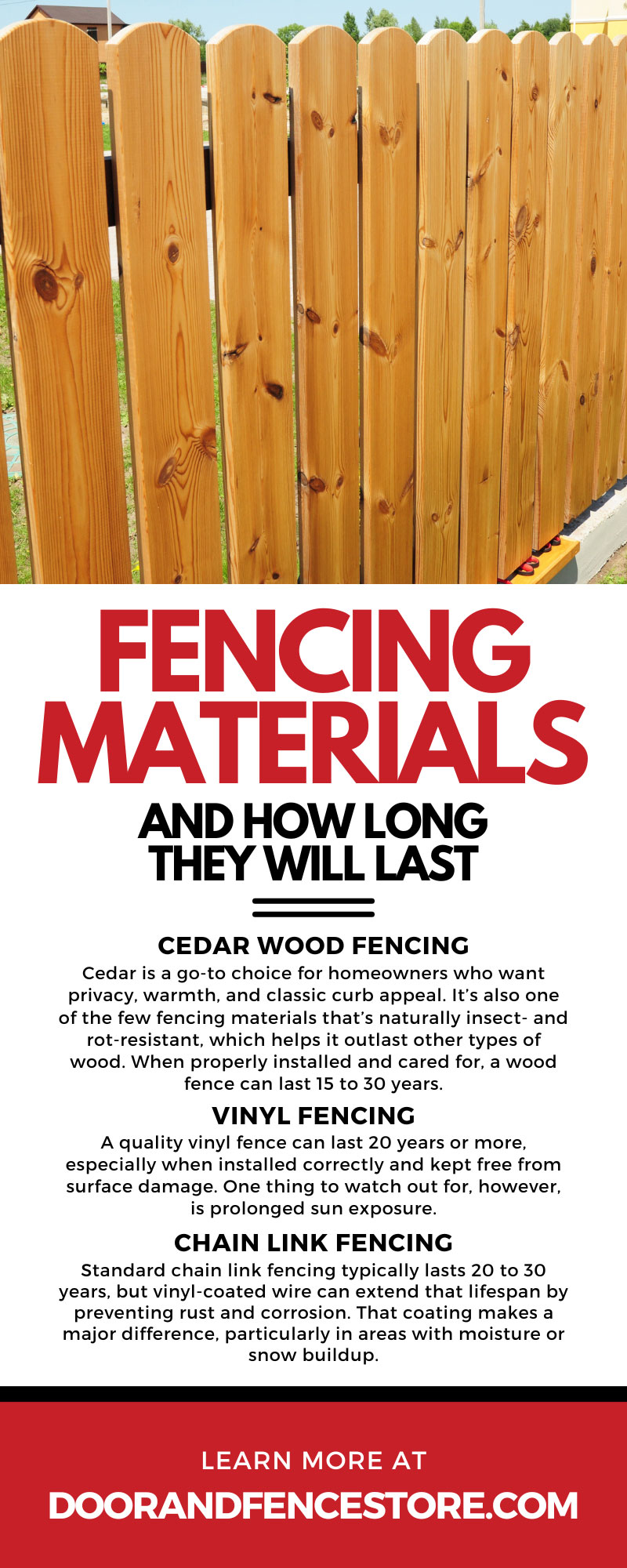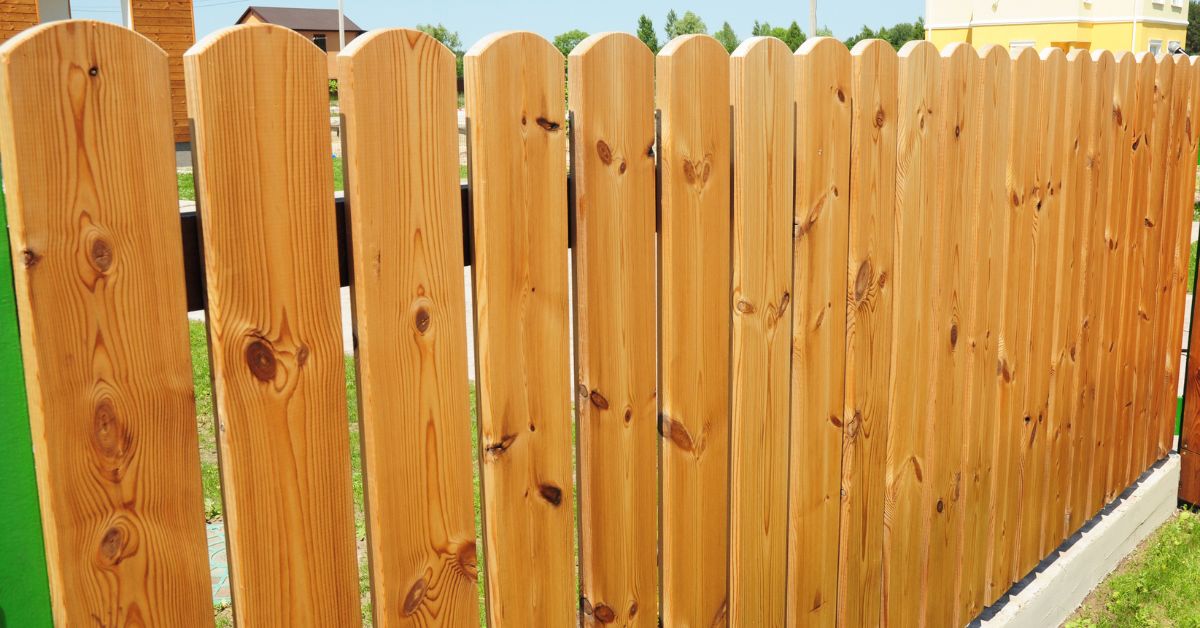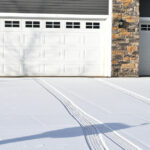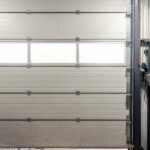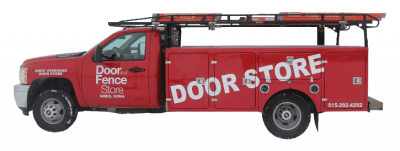You’ve finally decided to fence in your backyard. Maybe you’re looking for privacy, a safe space for your kids or pets, or simply something to define your property line. But as you start exploring materials, you begin to wonder about the longevity of the fence.
The truth is, longevity depends on more than just the material; it’s shaped by everything from soil conditions to sun exposure and even how your fence is installed. Still, it helps to begin with a baseline.
Here’s what to know about our four fencing materials and how long they will last.
Cedar Wood Fencing
Cedar is a go-to choice for homeowners who want privacy, warmth, and classic curb appeal. It’s also one of the few fencing materials that’s naturally insect- and rot-resistant, which helps it outlast other types of wood. When properly installed and cared for, a wood fence can last 15 to 30 years.
The biggest difference often comes down to whether or not you’re using PostMaster posts instead of wood. PostMaster posts resist bending, warping, and rot far better than traditional wooden posts, adding years to a fence’s structural integrity.
Another key factor is sealing. To maximize its lifespan, plan to apply a protective sealant every 2 to 3 years.
Cedar also offers a wide range of style options, including solid panels for privacy and decorative picket styles. And since it’s locally sourced in many parts of the Midwest, it’s a material that feels durable and familiar.
Vinyl Fencing
For homeowners who want a low-maintenance solution, vinyl fencing is tough to beat. Unlike wood, vinyl doesn’t splinter, rot, or attract termites. The material is also easy to clean. A quick rinse with a hose every 3 months is enough to keep it looking sharp.
A quality vinyl fence can last 20 years or more, especially when installed correctly and kept free from surface damage. One thing to watch out for, however, is prolonged sun exposure.
Over time, unprotected vinyl can discolor or become brittle in areas with intense UV rays. Choosing a vinyl fence with built-in UV inhibitors will reduce that risk and help preserve its structural integrity.
Vinyl works well in flat, open spaces and offers plenty of design flexibility. If you’re after clean lines and minimal upkeep, this material provides long-term value and consistency.
Chain Link Fencing
Chain link is the most practical choice for homeowners looking to secure pets, mark boundaries, or fence in a garden. While not known for its aesthetics, today’s options come in coated finishes that help them blend into surrounding landscapes.
Standard chain link fencing typically lasts 20 to 30 years, but vinyl-coated wire can extend that lifespan by preventing rust and corrosion. That coating makes a major difference, particularly in areas with moisture or snow buildup.
Fast installation and durability make it an ideal option for quick residential projects and side yards. While it doesn’t offer the privacy of wood or vinyl, chain link remains a reliable workhorse.
Ornamental Steel Fencing
When longevity is the top priority, ornamental steel is the clear standout. Designed for both style and strength, these fences are built to handle extreme wind, moisture, and terrain changes. Powder-coated finishes offer another layer of protection, reducing the risk of rust and fading.
A properly installed ornamental steel fence can last up to 50 years. It’s also one of the few fencing types that performs just as well on slopes as it does on flat ground, making it a smart choice for uneven or challenging landscapes.
With its upscale look and nearly unmatched lifespan, ornamental steel combines form and function in a way few materials can. It’s ideal for homeowners who want both visual impact and long-term value.
Installation Quality
No material, no matter how high-quality, can compensate for poor installation. A fence is only as strong as its posts, and that strength depends on post depth, spacing, and how the posts are anchored. If they’re set too shallow or not properly leveled, even minor wind or frost shifts can cause the structure to lean or sag.
Experienced wood fence installers know how foundational details such as post placement and anchoring affect long-term durability. In areas with clay-heavy or fast-draining subsoils, they’ll account for how moisture will behave around the posts.
Good installers will incorporate proper drainage strategies, such as gravel fill at the base of each posthole, and maintain consistent spacing that matches the load capacity of the chosen material.
Weather and Climate Exposure
The weather in Ames, Iowa, presents challenges that can shorten or lengthen a fence’s lifespan, depending on how well those elements are anticipated. Cold temperatures cause natural materials such as wood to warp or crack. Snow accumulation adds weight and prolonged moisture exposure, accelerating rot or rust if the materials aren’t protected.
Sunlight can also take its toll. Over time, UV rays will fade painted finishes, discolor vinyl, and dry out wood. A fence that sits in full sun for 12 hours a day will age very differently than one shaded for most of the afternoon. This makes orientation and placement important, too. Fences facing prevailing winds or sun paths may need more frequent attention.
Maintenance and Upkeep
Ongoing care plays a direct role in how long fencing lasts. For cedar, apply a protective sealant every 2 to 3 years. In high-moisture areas, inspect posts and panels every 6 months for signs of rot or insect activity. Vinyl requires a light rinse every 3 months and should be checked for cracks or brittleness once a year, particularly after extreme heat or cold.
Chain link fences benefit from an annual check of tension wire and a biannual inspection of the coated finish, primarily in areas with salt runoff. Ornamental steel, while very low maintenance, should be inspected once a year for chips in the powder coating and cleaned with water and mild soap every spring to prevent corrosion.
These small tasks can easily extend a fence’s lifespan by 5 to 10 years or more.
Choose Craftsmanship That Lasts
When it comes to fencing materials and how long they will last, your installer matters just as much as your material. Local conditions, property layout, and long-term performance all depend on experience and attention to detail, something off-the-shelf solutions or quick-install teams can’t always provide.
At The Door & Fence Store, we bring more than 49 years of expertise to every project. Based in Ames, Iowa, we specialize in wood, vinyl, chain link, and steel fencing tailored to the Midwest climate. Our partnership with Master Halco ensures that every material we install meets the highest manufacturing standards, while our team ensures those materials are installed to last.
As a locally owned business, we understand what Central Iowa homeowners need from their fences: strength, style, and the kind of reliability that doesn’t require constant repairs. If you’re looking for trusted craftsmanship and real, long-term value, we’re here to help you choose a solution built to last.
